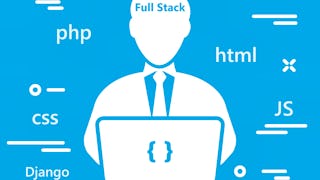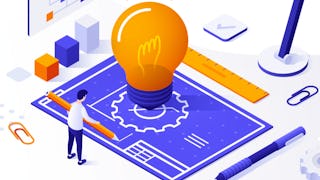Showcase your DevOps and Software Engineering skills with this hands-on Capstone project! In this course you will apply the skills and techniques you have learned as part of the previous courses in the Professional Certificate. During the project you will develop, test, deploy, monitor, and enhance a secure microservices-based application on Cloud, over the course of several sprints.

Gain next-level skills with Coursera Plus for $199 (regularly $399). Save now.

DevOps Capstone Project
This course is part of multiple programs.


Instructors: John Rofrano
Top Instructor
17,715 already enrolled
Included with
(168 reviews)
Recommended experience
What you'll learn
Identify user requirements, write user stories, create and execute sprint plans.
Build an application composed of several microservices and employ containers and serverless for running apps in Cloud.
Develop test cases and test your app during various stages of its lifecycle; utilize CI/CD tools to update and deploy your app.
List several next steps for starting or enhancing your career as a DevOps professional.
Skills you'll gain
Details to know

Add to your LinkedIn profile
13 assignments
See how employees at top companies are mastering in-demand skills

Build your subject-matter expertise
- Learn new concepts from industry experts
- Gain a foundational understanding of a subject or tool
- Develop job-relevant skills with hands-on projects
- Earn a shareable career certificate from IBM

There are 7 modules in this course
Before starting this module, ensure that you have a basic understanding of Agile planning and Scrum, as well as a GitHub account and a Zenhub account. This module focuses on developing an Agile plan to create a RESTful microservice. You will complete this project over several sprints using various Agile, cloud-native, and CI/CD tools and technologies. You will begin by creating a GitHub repository for the project and adding this repository to your Kanban board. Next, you will build a user story template in GitHub, which you will later use to write well-structured user stories. Then, you will build your product backlog on the Kanban board. After finishing your product backlog, you will build your sprint plan.
What's included
1 video3 readings2 assignments3 plugins
In this module, you will complete Sprint 1 by configuring the capstone project environment and developing the Customer Account microservice using test driven development (TDD). Start development of the microservice on a new branch on your GitHub repo. You will create tests for the RESTful Flask service and write test cases for the read, update, delete, and list functions. to pass these tests. As you develop, you will run nosetests to ensure at least 95% coverage. As your work progresses, you will move the user stories through your kanban board.
What's included
3 readings2 assignments1 app item1 plugin
Before starting this module, ensure that you have completed all the steps described in the Hands-on Lab: Develop Your RESTful Service Using Test Driven Development. In addition, you should have a GitHub account and a GitHub repository, a basic understanding of YAML, familiarity with the syntax for GitHub Actions, and a basic knowledge of Python, Pip, and nosetests. In Lesson 1, you will add a continuous integration workflow using GitHub Actions, which will help you automate the building and testing of your code. You will start by building a plan for Sprint 2 in the guided instructional lab, Sprint 2 Planning. Next, in the Add Continuous Integration hands-on lab, you will configure a GitHub Actions workflow that will be triggered when an event occurs in your repository. As part of Sprint 2, you will create a workflow that will build and test every push or pull request to your repository. You will be moving the corresponding user stories through your kanban board as your work progresses. Before starting Lesson 2, ensure that you have completed all the steps described in the Hands-on Lab: Add Continuous Integration. In addition, you should have a basic understanding of security headers, cross-origin resource sharing (CORS) policies, Flask-Talisman, and Flask-Cors. You should also have a good understanding of test driven development (TDD) techniques, GitHub Actions, and GitHub operations (branching, merging, committing code, pushing code updates, and creating pull requests). In Lesson 2, you will add secure code practices for the microservice you built by adding Flask-Talisman for security headers and Flask-Cors to establish CORS policies. To begin, you will assign the relevant story created for this task to yourself and start working on a new branch created for this specific task. To align with TDD practices, you will first write the test case for the security feature you are trying to implement. Once you have added Flask-Talisman for security headers and Flask-Cors to establish CORS policies, commit and push your changes to the repository and make a pull request that will kick off the GitHub Action. You will move the corresponding user stories through your kanban board as your work progresses.
What's included
5 readings4 assignments2 app items1 plugin
Before starting this module, ensure that you have completed all the steps described in the Hands-on Lab: Add Security to Your RESTful Service. In addition, you should have a basic understanding of Docker and containerization, Docker commands, Kubernetes and OpenShift, YAML, kubectl, and oc commands. You should have a GitHub account and a GitHub repository, and you should be familiar with the syntax for GitHub Actions. As part of Sprint 3, you will create a Docker image of your microservice and deploy the same to Kubernetes/OpenShift cluster manually. You will first find the “Containerize your microservice using Docker” story in the kanban board, move it to "In Progress," and assign it to yourself. Next, you will create the Docker file and then use it to build a Docker image called accounts. You will deploy this image to Kubernetes/OpenShift as part of the next user story, “Deploy your Docker image to Kubernetes.” You will create new branches for both stories and begin working on them. Once the tasks are completed, you will commit and push your changes from your local environment to your GitHub repository. Finally, you will create pull requests and merge your code to the main or master branch. You will move the corresponding user stories through your kanban board as your work progresses. When you complete a story, you will move it to "Done" and from there to "Closed."
What's included
3 readings2 assignments1 app item1 plugin
Before starting this module, ensure that you have completed all the steps described in the Hands-on Lab: Deploy Your Application to Kubernetes. In addition, you should have a basic understanding of Kubernetes and continuous delivery, Tekton pipeline, YAML, kubectl, and oc commands. You should have a GitHub account and a GitHub repository, and you should be familiar with the syntax for GitHub Actions. For the lab in this module, you will automate the deployment to Kubernetes using the Tekton pipeline so that when the pipeline is triggered, the accounts service will be deployed to Kubernetes without requiring any manual intervention. To start, you will find the user story "Create a CD pipeline to automate deployment to Kubernetes" in the kanban board, move it from the "Sprint Backlog" to "In Progress," and assign it to yourself. Next, you will create the CD pipeline, involving tasks for cloning, linting, unit testing, building, and deploying the service to an OpenShift/Kubernetes cluster. You will also create a Tekton trigger using the Tekton Catalog, such as a commit to your GitHub repository, which will initiate the pipeline run. You will create a new branch for this story and start working on it. Once the task is completed, you will commit and push your changes from your local environment to your GitHub repository. Finally, you will create pull requests and merge your code to the main or master branch. You will move the corresponding user stories through your kanban board as your work progresses. When you complete a story, you will move it to "Done" and from there to "Closed."
What's included
3 readings2 assignments1 app item
In this final module, you will complete your submission of screenshots and URLs from the hands-on labs for final evaluation.
What's included
2 readings1 peer review1 app item1 plugin
What's included
1 reading1 assignment
Earn a career certificate
Add this credential to your LinkedIn profile, resume, or CV. Share it on social media and in your performance review.
Instructors


Offered by
Explore more from Software Development
 Status: Free Trial
Status: Free Trial Status: Free TrialStatus: AI skills
Status: Free TrialStatus: AI skills Status: Free Trial
Status: Free Trial Status: Free Trial
Status: Free Trial
Why people choose Coursera for their career




Learner reviews
168 reviews
- 5 stars
85.11%
- 4 stars
10.71%
- 3 stars
0.59%
- 2 stars
1.19%
- 1 star
2.38%
Showing 3 of 168
Reviewed on Mar 25, 2023
A great project to see the previous course material all coordinated and in action. It is current, and I see the relevancy of it (from the job descriptions I see on LinkedIn, Indeed, etc..). Thank you
Reviewed on Dec 4, 2024
I learned a bunch and am applying this knowledge to my current work project. The dependencies on open source apps can be a hurdle in the business environment.
Reviewed on Jul 28, 2025
Very detailed and I really enjoyed the program though it had some parts that was more difficult than I imaged, I enjoyed it.
Frequently asked questions
No. This is an introductory course that assumes no prior knowledge of DevOps.
You will need to sign up for a no-charge GitHub account and use other no-charge tools from IBM in your browser.
To access the course materials, assignments and to earn a Certificate, you will need to purchase the Certificate experience when you enroll in a course. You can try a Free Trial instead, or apply for Financial Aid. The course may offer 'Full Course, No Certificate' instead. This option lets you see all course materials, submit required assessments, and get a final grade. This also means that you will not be able to purchase a Certificate experience.
More questions
Financial aid available,





